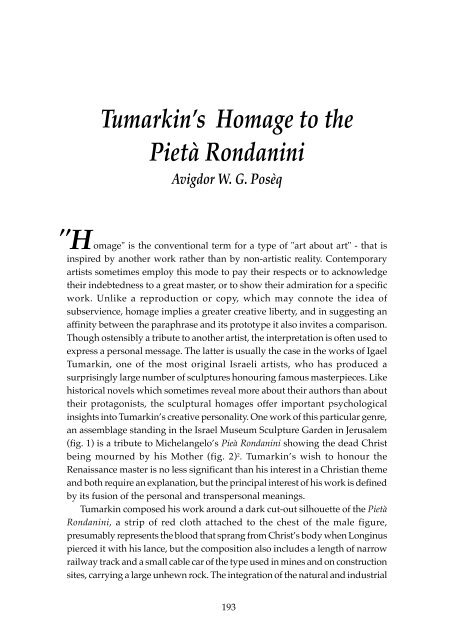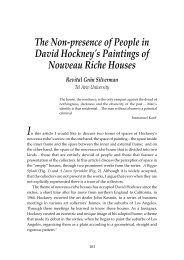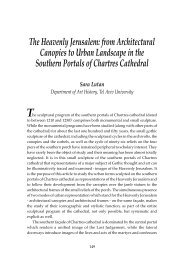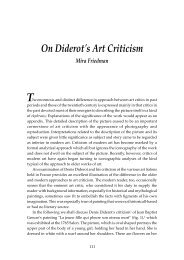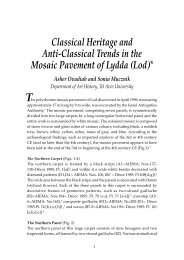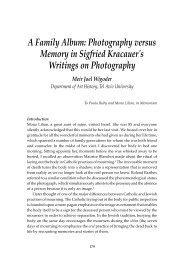Tumarkin's Homage to the Pietà Rondanini Avigdor WG Posèq
Tumarkin's Homage to the Pietà Rondanini Avigdor WG Posèq
Tumarkin's Homage to the Pietà Rondanini Avigdor WG Posèq
Create successful ePaper yourself
Turn your PDF publications into a flip-book with our unique Google optimized e-Paper software.
Tumarkin’s <strong>Homage</strong> <strong>to</strong> <strong>the</strong><br />
<strong>Pietà</strong> <strong>Rondanini</strong><br />
<strong>Avigdor</strong> W. G. <strong>Posèq</strong><br />
"H omage" is <strong>the</strong> conventional term for a type of "art about art" - that is<br />
inspired by ano<strong>the</strong>r work ra<strong>the</strong>r than by non-artistic reality. Contemporary<br />
artists sometimes employ this mode <strong>to</strong> pay <strong>the</strong>ir respects or <strong>to</strong> acknowledge<br />
<strong>the</strong>ir indebtedness <strong>to</strong> a great master, or <strong>to</strong> show <strong>the</strong>ir admiration for a specific<br />
work. Unlike a reproduction or copy, which may connote <strong>the</strong> idea of<br />
subservience, homage implies a greater creative liberty, and in suggesting an<br />
affinity between <strong>the</strong> paraphrase and its pro<strong>to</strong>type it also invites a comparison.<br />
Though ostensibly a tribute <strong>to</strong> ano<strong>the</strong>r artist, <strong>the</strong> interpretation is often used <strong>to</strong><br />
express a personal message. The latter is usually <strong>the</strong> case in <strong>the</strong> works of Igael<br />
Tumarkin, one of <strong>the</strong> most original Israeli artists, who has produced a<br />
surprisingly large number of sculptures honouring famous masterpieces. Like<br />
his<strong>to</strong>rical novels which sometimes reveal more about <strong>the</strong>ir authors than about<br />
<strong>the</strong>ir protagonists, <strong>the</strong> sculptural homages offer important psychological<br />
insights in<strong>to</strong> Tumarkin’s creative personality. One work of this particular genre,<br />
an assemblage standing in <strong>the</strong> Israel Museum Sculpture Garden in Jerusalem<br />
(fig. 1) is a tribute <strong>to</strong> Michelangelo’s Pieà <strong>Rondanini</strong> showing <strong>the</strong> dead Christ<br />
being mourned by his Mo<strong>the</strong>r (fig. 2) 2 . Tumarkin’s wish <strong>to</strong> honour <strong>the</strong><br />
Renaissance master is no less significant than his interest in a Christian <strong>the</strong>me<br />
and both require an explanation, but <strong>the</strong> principal interest of his work is defined<br />
by its fusion of <strong>the</strong> personal and transpersonal meanings.<br />
Tumarkin composed his work around a dark cut-out silhouette of <strong>the</strong> <strong>Pietà</strong><br />
<strong>Rondanini</strong>, a strip of red cloth attached <strong>to</strong> <strong>the</strong> chest of <strong>the</strong> male figure,<br />
presumably represents <strong>the</strong> blood that sprang from Christ’s body when Longinus<br />
pierced it with his lance, but <strong>the</strong> composition also includes a length of narrow<br />
railway track and a small cable car of <strong>the</strong> type used in mines and on construction<br />
sites, carrying a large unhewn rock. The integration of <strong>the</strong> natural and industrial<br />
193
Fig. 1: Tumarkin, <strong>Pietà</strong> <strong>Rondanini</strong>. Assemblage, 1987. Jerusalem, Israel<br />
Museum Sculpture Garden.<br />
elements with <strong>the</strong> figures cut out of ‘corten’ sheets emphasizes <strong>the</strong> fact that<br />
Tumarkin’s <strong>Pietà</strong> is no mere replica of its Renaissance model. The transposition<br />
of <strong>the</strong> Chris<strong>to</strong>logical motif in<strong>to</strong> ano<strong>the</strong>r sculptural medium is reflected both in<br />
<strong>the</strong> work’s meaning as a modern artists’ tribute <strong>to</strong> Michelangelo, and its own<br />
aes<strong>the</strong>tic significance.<br />
Leaving <strong>the</strong> discussion of content <strong>to</strong> a later part of this paper, we shall first<br />
address ourselves <strong>to</strong> <strong>the</strong> purely sculptural aspects of Tumarkin’s translation of<br />
Michelangelo’s marble statue in<strong>to</strong> essentially two-dimensional shapes and of<br />
194
<strong>the</strong> new elements which have been added <strong>to</strong> it. The shadowy mo<strong>the</strong>r figure,<br />
somewhat resembling a shooting gallery target, supports <strong>the</strong> body of her son<br />
which looks like an oversize marionette, but in acknowledging <strong>the</strong> tactile quality<br />
of his Renaissance model Tumarkin pushed back <strong>the</strong> profile which is cut in<strong>to</strong><br />
<strong>the</strong> mo<strong>the</strong>r's silhouette, bent <strong>the</strong> head of <strong>the</strong> male figure and moved his limbs.<br />
3 The arrangement of <strong>the</strong> flat shapes create a suggestion of an ephemeral<br />
volumes which may be related <strong>to</strong> <strong>the</strong> Constructivist concept of sculptural form<br />
as "negative space", while <strong>the</strong> integration of <strong>the</strong> "ready made" wagon and <strong>the</strong><br />
objet trouvé s<strong>to</strong>ne with figurative components may be seen as a fur<strong>the</strong>r<br />
endeavour <strong>to</strong> reconcile <strong>the</strong> contemporary methods with <strong>the</strong> artistic tradition<br />
of <strong>the</strong> Renaissance. 4<br />
Tumarkin’s juxtaposition of <strong>the</strong> shadow-like and three-dimensional<br />
elements also brings <strong>to</strong> mind <strong>the</strong> humanist controversy over <strong>the</strong> origins of<br />
sculpture. Renaissance <strong>the</strong>orists traced <strong>the</strong> evolution of <strong>the</strong> art <strong>to</strong> <strong>the</strong> incidental<br />
evocativeness of <strong>the</strong> shapes of natural objects such as tree trunks and clods of<br />
earth which, as claimed by Alberti, early artists gradually worked in<strong>to</strong> realistic<br />
representations. Classical authors on <strong>the</strong> o<strong>the</strong>r hand, believed that sculpture,<br />
like painting, originated in <strong>the</strong> linear tracing of <strong>the</strong> human shade. 5 By combining<br />
<strong>the</strong> silhouettes with <strong>the</strong> unhewn rock Tumarkin claims his work's descendency<br />
from both traditions, while <strong>the</strong> fact that <strong>the</strong> Israel Museum <strong>Pietà</strong> may be seen<br />
both as a flat “pic<strong>to</strong>rial” image and sculptural composition implicitly associates<br />
its maker with Michelangelo’s multifaceted dexterity. Tumarkin was probably<br />
aware that <strong>the</strong> Renaissance dispute about <strong>the</strong> relative supremacy of painting<br />
over sculpture had been resolved by declaring <strong>the</strong> disegno as "<strong>the</strong> parent of all<br />
arts". 6 By way of a gesture <strong>to</strong> this <strong>the</strong>ory he left on <strong>the</strong> cut out figures several<br />
sketchy linear marks like a prepara<strong>to</strong>ry drawing. In suggesting that <strong>the</strong> work<br />
is not quite finished <strong>the</strong>se marks also evoke <strong>the</strong> seemingly unfinished<br />
appearance of some of Michelangelo’s statues. 7 The rough non-fini<strong>to</strong> effect is<br />
especially characteristic of <strong>the</strong> <strong>Rondanini</strong> <strong>Pietà</strong>, which though completed before<br />
1563, was reworked by Michelangelo six days before his death (in 1564) and<br />
left in a rudimentary state. 8 The broken fragments of <strong>the</strong> original composition<br />
and <strong>the</strong> marks of <strong>the</strong> chisel remaining on <strong>the</strong> figure counteract <strong>the</strong>ir<br />
representational purpose, so that <strong>the</strong> group is perceived as a roughly carved<br />
piece of marble.<br />
Michelangelo’s search for a new solution <strong>to</strong> an already finished work has<br />
always been unders<strong>to</strong>od as a moving testimony of <strong>the</strong> persistence of <strong>the</strong> master's<br />
creative urge even in old age, and though in fact <strong>the</strong> <strong>Rondanini</strong> <strong>Pietà</strong> is not<br />
finished, it has been acclaimed as a culmination of Michelangelo’s artistic<br />
achievement. Tumarkin expressed his particular appreciation of this<br />
195
masterpiece in a short article on "Michelangelo and <strong>the</strong> End of Marble Statuary",<br />
in his very personal survey of landmarks in <strong>the</strong> his<strong>to</strong>ry of sculpture. 9 The title<br />
of this book, From Earth <strong>to</strong> Earth Art, recalls <strong>the</strong> Renaissance <strong>the</strong>ory of <strong>the</strong><br />
development of figural sculpture from natural objects; unlike Alberti, however,<br />
Tumarkin conceives <strong>the</strong> mimetic tendency as an intermediary phase. In<br />
discussing Michelangelo’s position in this evolution he notes <strong>the</strong> extent <strong>to</strong> which<br />
<strong>the</strong> <strong>Pietà</strong> <strong>Rondanini</strong> diverges from earlier versions of <strong>the</strong> same subjects and<br />
marvels at Michelangelo’s almost sensual attitude <strong>to</strong> <strong>the</strong> roughly worked<br />
Carrara marble. He particularly stresses <strong>the</strong> parallelism between <strong>the</strong> non fini<strong>to</strong><br />
effect, which he says “seems like an understated reflection of <strong>the</strong> creative<br />
moment in which <strong>the</strong> mutilated appearance of <strong>the</strong> figures harmonizes with<br />
<strong>the</strong> tragic <strong>the</strong>me, and Michelangelo’s coming <strong>to</strong> terms with his lifelong personal<br />
problems”. He claims that “as an embodiment of <strong>the</strong> completeness of <strong>the</strong><br />
incomplete, <strong>the</strong> marble group fully conveys all that <strong>the</strong> artist wished <strong>to</strong> say;<br />
196<br />
Fig. 2: Michaelangelo, <strong>Pietà</strong><br />
<strong>Rondanini</strong>. Marble, 1564. Milan.<br />
Castello Sforzesco.
any fur<strong>the</strong>r <strong>to</strong>uch would have been redundant and even detrimental <strong>to</strong> its<br />
perfection - but <strong>the</strong> very plenitude of Michelangelo’s message also represents<br />
<strong>the</strong> end of carving in marble as an artistic medium”. Elsewhere in his book<br />
Tumarkin praises primitive artists, especially African sculp<strong>to</strong>rs who, free from<br />
Western conventions and using divergent techniques, created superb works<br />
that brea<strong>the</strong>d new life in<strong>to</strong> modern art. 10 He admires especially <strong>the</strong> African<br />
sculp<strong>to</strong>rs’ skillful use of simple materials, and says of himself that he <strong>to</strong>o<br />
endeavours <strong>to</strong> create something new by composing everyday functional<br />
implements in a new context. This may be exemplified in <strong>the</strong> real troley and<br />
railway track which he added <strong>to</strong> his <strong>Pietà</strong>. The essentially non-mimetic aspect<br />
of this assemblage may thus be seen as its author’s deliberate reaction <strong>to</strong> <strong>the</strong><br />
concept of sculpture as an imitative art which, he feels, exhausted itself in<br />
Michelangelo’s last work. This concept of <strong>the</strong> <strong>Pietà</strong> <strong>Rondanini</strong>, as final expression<br />
of a venerable tradition, only sharpened Tumarkin’s attention of <strong>the</strong> emotional<br />
content of this statue.<br />
The special meaning of Michelangelo’s configuration has been widely<br />
discussed by art his<strong>to</strong>rians, with particular emphasis on <strong>the</strong> departure from<br />
<strong>the</strong> conventional formulas of <strong>the</strong> "Lamentation of Christ", which show Christ’s<br />
body ei<strong>the</strong>r prostrate on <strong>the</strong> ground or held on Mary’s lap, as in <strong>the</strong> Bella <strong>Pietà</strong><br />
Michelangelo’s earliest version of <strong>the</strong> subject. 11 The innova<strong>to</strong>ry concept of <strong>the</strong><br />
dead Christ standing vertically and seemingly absorbed in<strong>to</strong> his mo<strong>the</strong>r’s body<br />
has also attracted <strong>the</strong> attention of psychoanalysts, who have approached <strong>the</strong><br />
<strong>Pietà</strong> <strong>Rondanini</strong> against <strong>the</strong> background of Michelangelo’s childhood<br />
experiences, stressing <strong>the</strong> traumatic loss of his mo<strong>the</strong>r and lack of warmth in<br />
his relations with his fa<strong>the</strong>r, which in maturity resulted in a subconscious search<br />
for surrogate parent figures. 12 Michelangelo’s various representations of <strong>the</strong><br />
Madonna and Child, and also <strong>the</strong> early <strong>Pietà</strong> have been interpreted as a<br />
projection of his neurotic longing for mo<strong>the</strong>r love, while <strong>the</strong> <strong>Pietà</strong> <strong>Rondanini</strong><br />
has accordingly been unders<strong>to</strong>od as a symbolic expression of Michelangelo’s<br />
wish <strong>to</strong> be reunited with his mo<strong>the</strong>r, coinciding with <strong>the</strong> conscious awareness<br />
that <strong>the</strong> realization of this wish was possible only in death. 13<br />
Psychological insights are sometimes compared <strong>to</strong> artistic intuition and this<br />
may be especially true of <strong>the</strong> creative individual’s instinctive comprehension<br />
of <strong>the</strong> latent content of <strong>the</strong> work of ano<strong>the</strong>r artist. 14 Tumarkin’s spontaneous<br />
perception of <strong>the</strong> special personal meaning of Michelangelo’s last work as a<br />
<strong>to</strong>ken of his coming <strong>to</strong> terms with his life-long problems, was probably<br />
facilitated by certain analogies in his own childhood experiences which, like<br />
Michelangelo, he constantly exorcises in his art. 15 He was born in 1933 <strong>to</strong> a<br />
German fa<strong>the</strong>r and a Jewish mo<strong>the</strong>r who, submitting <strong>to</strong> racial laws, divorced<br />
197
her husband and fled Germany with her child. She settled in a Tel-Aviv suburb,<br />
remarried, and <strong>to</strong> save her son from social ostracism concealed his paternity<br />
from him. Tumarkin’s childhood discovery that his mo<strong>the</strong>r’s husband was not<br />
his parent, while his true fa<strong>the</strong>r belonged <strong>to</strong> a nation actively engaged in <strong>the</strong><br />
annihilation of <strong>the</strong> people whom he had come <strong>to</strong> regard as his own, was an<br />
overwhelming experience. His emotional distress resulted in unruly behaviour<br />
which caused him <strong>to</strong> be sent away from home, increasing his sense of alienation.<br />
In his helpless rage he turned against his mo<strong>the</strong>r and rejecting her love, blamed<br />
her for depriving him of a fa<strong>the</strong>r. 16<br />
As he grew up he sought substitute parent figures. Initially he attached<br />
himself <strong>to</strong> <strong>the</strong> German-born Israeli sculp<strong>to</strong>r Rudi Lehman, 17 but as his artistic<br />
horizons widened he also claimed his fa<strong>the</strong>r's cultural heritage, adopting great<br />
German artists as models. 18 He was especially attracted <strong>to</strong> Dürer and Grünewald<br />
and repeatedly expressed his admiration of <strong>the</strong>ir work in au<strong>to</strong>biographical<br />
compositions. One of <strong>the</strong>se, featuring a mask cast from Tumarkin’s own face,<br />
is an assemblage designed <strong>to</strong> evoke Dürer’s remarkable self-portrait as Salva<strong>to</strong>r<br />
Mundi. 19 Since Tumarkin’s implicit self-identification with Christ is also reflected<br />
in his several Crucifixions inspired by Grünewald’s Isenheim altarpiece, 20 one<br />
may assume that <strong>the</strong> same concept persists in his homage <strong>to</strong> Michelangelo,<br />
and that in adopting <strong>the</strong> Italian master as ano<strong>the</strong>r paradigm he also followed<br />
him in his personal interpretation of <strong>the</strong> "<strong>Pietà</strong>" using <strong>the</strong> Chris<strong>to</strong>logical subject<br />
as vehicle of his own memories. He may have associated <strong>the</strong> tragic <strong>the</strong>me with<br />
his personal experiences, evoking in <strong>the</strong> marionette-like figure of <strong>the</strong> son <strong>the</strong><br />
traumatic feeling of puppet-like control by his mo<strong>the</strong>r. One notes especially<br />
that, unlike Michelangelo’s mo<strong>the</strong>r who seems <strong>to</strong> participate in Christ's ordeal,<br />
in Tumarkin’s version <strong>the</strong> mo<strong>the</strong>r turns away from her son, implying a heartless<br />
indifference. 21 Assuming that Tumarkin identified with <strong>the</strong> son, his <strong>Pietà</strong> may<br />
be unders<strong>to</strong>od not only as a <strong>to</strong>ken of respect <strong>to</strong>wards Michelangelo as a<br />
surrogate parent figure, but also as an expression of suppressed longing for<br />
<strong>the</strong> parental love of which he had been deprived in his youth. The submerged<br />
reference <strong>to</strong> <strong>the</strong> trauma is fur<strong>the</strong>r enhanced by <strong>the</strong> assemblage’s o<strong>the</strong>r<br />
components which are without counterpart in <strong>the</strong> Renaissance pro<strong>to</strong>type.<br />
The unhewn rock: this, being part of a work dedicated <strong>to</strong> Michelangelo,<br />
may perhaps be associated with Michelangelo’s love of marble, in which<br />
psychoanalysts have discerned a subconscious expression of his longing for a<br />
nurturing mo<strong>the</strong>r. 22 Tumarkin also has a deep respect for s<strong>to</strong>nes 23 which in his<br />
case <strong>to</strong>o, may reflect a "mo<strong>the</strong>r complex". Unlike Michelangelo, however, he<br />
seldom uses any carving instruments. The unhewn rock evoking <strong>the</strong> Biblical<br />
concept of <strong>the</strong> sanctity of natural s<strong>to</strong>nes ("for if thou lift up thy <strong>to</strong>ol upon it,<br />
198
Fig. 3: Tumarkin Von den ‘Dicken Bertha’ bis zur ‘Roter Rosa’ Assemblage 1985.<br />
thou has polluted it", Ex. 20:25) 24 may perhaps imply Tumarkin’s latent tendency<br />
<strong>to</strong> cherish an ideal mo<strong>the</strong>r image. One notes, however, that in contrast <strong>to</strong> <strong>the</strong><br />
s<strong>to</strong>nes in <strong>the</strong> Bible which were left in <strong>the</strong>ir natural location, in <strong>the</strong> Israel Museum<br />
<strong>Pietà</strong> <strong>the</strong> rock is pulled by a steel cord attached <strong>to</strong> <strong>the</strong> son's heart and removed<br />
from its natural site by a cable car. In Tumarkin’s works of <strong>the</strong> 1980s cable cars<br />
and tracks are sometimes used <strong>to</strong> suggest <strong>the</strong> causative interrelation of<br />
seemingly disparate fac<strong>to</strong>rs: e.g., in <strong>the</strong> several versions of a composition bearing<br />
<strong>the</strong> German title Von den ‘Dicken Berta’ bis zur ‘Roter Rosa’ (From "Big Bertha" <strong>to</strong><br />
<strong>the</strong> "Red Rosa") 25 a canon on wheels representing <strong>the</strong> famous First World War<br />
gun linked by rails <strong>to</strong> a silhouette of Rosa Luxembourg who was murdered in<br />
1919, is a commentary on <strong>the</strong> evolution of German militarism in<strong>to</strong> political<br />
terror. A similar car, also on rails, occurs in ano<strong>the</strong>r assemblage called<br />
Deutschland, ein Wintermärchen ("Germany, a Wintertale") (fig. 3). 26 The title was<br />
adopted from Heinrich Heine's cycle of satirical poems in which <strong>the</strong> Jewish<br />
poet declares himself a lover of German culture and denounces Prussian<br />
chauvinism. 27 Tumarkin shares <strong>the</strong>se mixed sentiments. In his own Wintertale<br />
<strong>the</strong> cable car throttles a human silhouette whose black and white stripes recall<br />
<strong>the</strong> uniform of concentration camp inmates, and <strong>the</strong> rails leading <strong>to</strong> nowhere<br />
199
Fig. 4: Tumarkin, Deutschland, ein Wintermärchen. Assemblage, 1985, destroyed.<br />
allude <strong>to</strong> <strong>the</strong> Nazi 'Final Solution. In <strong>the</strong> Israel Museum <strong>Pietà</strong> <strong>the</strong> rails and <strong>the</strong><br />
wagon loaded with <strong>the</strong> unhewn rock seem <strong>to</strong> symbolize <strong>the</strong> traumatic burden<br />
of such memories. The rock itself has additional meanings.<br />
In classical antiquity rough s<strong>to</strong>nes were venerated as symbols of Mo<strong>the</strong>r<br />
Earth (Cybele) and were believed <strong>to</strong> possess magical virtues or <strong>to</strong> be inhibited<br />
by spirits. The idea survived in medieval legends and in <strong>the</strong> mystic <strong>the</strong>ological<br />
concept of <strong>the</strong> "s<strong>to</strong>ne hewn by God" (i.e., natural rock) as <strong>the</strong> symbol of human<br />
consciousness. 28 The archetype significance of Tumarkin’s rock is made more<br />
explicit by <strong>the</strong> steel cord which links it <strong>to</strong> <strong>the</strong> male figure's heart, seeming <strong>to</strong><br />
tear him from his mo<strong>the</strong>r. The linkage of <strong>the</strong> s<strong>to</strong>ne with <strong>the</strong> figures is similar <strong>to</strong><br />
that of <strong>the</strong> Big Bertha and <strong>the</strong> Red Rosa but <strong>the</strong> meaning is anti<strong>the</strong>tical. Ra<strong>the</strong>r<br />
than being a target, <strong>the</strong> son painfully drags <strong>the</strong> rock - <strong>the</strong> motif reminds one of<br />
<strong>the</strong> legend of Sisyphus. 29 Tumarkin himself commented that "<strong>the</strong> son pulls and<br />
repulses that which cannot be done with nor without, and which forever is<br />
incomplete...". 30 If our former identification of <strong>the</strong> au<strong>to</strong>biographical significance<br />
of <strong>the</strong> marionette figure is correct, <strong>the</strong> unhewn s<strong>to</strong>ne represents not only <strong>the</strong><br />
<strong>the</strong>me of maternity and <strong>the</strong> burden of Tumarkin’s childhood memories but<br />
also <strong>the</strong> lasting memory of <strong>the</strong> German atrocities which, like Sisyphus, he is<br />
doomed perpetually <strong>to</strong> drag with him. His inner conflict is <strong>the</strong>refore even more<br />
painful than that of Heine. The <strong>Pietà</strong> assemblage alludes <strong>to</strong> <strong>the</strong> tragedy of Jews<br />
brought up in <strong>the</strong> reverence of European culture.<br />
In summing, up we may contend that <strong>the</strong> significance of Tumarkin’s<br />
200
assemblage is essentially different from that of its Renaissance pro<strong>to</strong>type against<br />
which he seems <strong>to</strong> react by using <strong>the</strong> modern techniques. The contrast is also<br />
reflected in <strong>the</strong> meaning of Tumarkin’s work. Moved by <strong>the</strong> sublime pathos of<br />
<strong>the</strong> <strong>Pietà</strong> <strong>Rondanini</strong>, Tumarkin associated himself with Michelangelo’s life-long<br />
quest for parental love; but, as a secular Jew, he is deprived even of <strong>the</strong> Italian<br />
master’s hope of finding it in death. Thus, ra<strong>the</strong>r than <strong>the</strong> yearned for o<strong>the</strong>r<br />
worldly bliss, <strong>the</strong> Israel Museum assemblage epi<strong>to</strong>mizes <strong>the</strong> misery of<br />
estrangement of its author and his inner need <strong>to</strong> alleviate his disorientation by<br />
relating his art <strong>to</strong> <strong>the</strong> sublime artistic tradition. However, his adaptation of <strong>the</strong><br />
Chris<strong>to</strong>logical motif has a deeper meaning which goes beyond that of his<br />
Renaissance model. While Michelangelo transformed a generic religious <strong>the</strong>me<br />
in<strong>to</strong> a personal allegory, <strong>the</strong> allusions <strong>to</strong> <strong>the</strong> traumatic experiences which<br />
Tumarkin shared with <strong>the</strong> rest of his generation elevate his au<strong>to</strong>biographical<br />
<strong>Pietà</strong> <strong>to</strong> <strong>the</strong> level of a transpersonal icon of <strong>the</strong> collective Jewish remembrance.<br />
The assemblage shows also that <strong>the</strong> Jewish character of a work need not be<br />
compromised by <strong>the</strong> reference <strong>to</strong> a non-Jewish iconographical motif, and that<br />
<strong>the</strong> work of a modern Israeli artist may be intensely personal and universal at<br />
<strong>the</strong> same time.<br />
NOTES<br />
This paper has been awarded <strong>the</strong> Hebrew Union College-Jewish Institute of<br />
Religion, in Jerusalem, Richard and Joan Scheuer Prize in Jewish Art and<br />
Architecture for <strong>the</strong> academic year 1995-96.<br />
1 The installation in 1987 of <strong>Tumarkin's</strong> work coincided with <strong>the</strong> Israel Museum<br />
publication of an illustrated catalogue of several of his assemblages with<br />
commentaries by M. Schneckenburger, art critic and direc<strong>to</strong>r of <strong>the</strong> 8th Documenta<br />
in Kassel, and Y. Zalmona, <strong>the</strong> Israel Museum cura<strong>to</strong>r for Israeli art, cf. Rails and<br />
<strong>Pietà</strong>. A version of <strong>the</strong> present paper was delivered as a lecture on: “Ambivalent<br />
Images of Son and Mo<strong>the</strong>r in Michelangelo and Tumarkin”, at <strong>the</strong> 17th Colloquium<br />
of <strong>the</strong> His<strong>to</strong>rical Society of Israel, Tel-Aviv, 1993.<br />
2 Michelangelo produced at least three sculptural versions of this subject. The “<strong>Pietà</strong><br />
<strong>Rondanini</strong>” is named after one of <strong>the</strong> early owners of this statue, which is now in<br />
<strong>the</strong> Castello Sforzesco in Milan; cf. Baldini, 142-147.<br />
3 Zalmona is right about “<strong>the</strong> tridimensional bodily solidity of <strong>the</strong> Renaissance<br />
sculpture” being replaced by what he calls “a two dimensional stage setting” but<br />
his description of <strong>the</strong> son as “a Karageöz shadow puppet” unnecessarily obscures<br />
<strong>the</strong> issue; Rails and <strong>Pietà</strong>.<br />
4 On <strong>Tumarkin's</strong> relation <strong>to</strong> <strong>the</strong> Parisian avant garde and on his innovative sculptural<br />
methods see: Tumarkin, 1970, 7-9. On his pioneering contribution <strong>to</strong> <strong>the</strong> new<br />
sculptural realism: Rails and <strong>Pietà</strong>.<br />
201
5 The role of shadows is described in Pliny (N.H. 35:151-152), while <strong>the</strong> Renaissance<br />
concept of <strong>the</strong> priority of evocative natural objects may be found in Alberti's treatise<br />
“On Sculpture”, Alberti/Grayson, 121-122. Alberti's notion was probably inspired<br />
by an imaginary reconstruction of <strong>the</strong> origins of classical hermae, <strong>Posèq</strong>, 1989a,<br />
380-384.<br />
6 The definition was coined by Vasari in <strong>the</strong> “Introduction” <strong>to</strong> <strong>the</strong> Vite; Vasari/<br />
Maclehose, 205. On <strong>the</strong> Renaissance dispute over <strong>the</strong> relative merits of <strong>the</strong> arts<br />
see: Blunt, 1940, 50ff., and Barasch, 1975, 163ff. For Michelangelo's position in this<br />
debate: Summers, 1981, 269-78 and 457.<br />
7 For an aes<strong>the</strong>tic evaluation of <strong>the</strong> non-fini<strong>to</strong> effects see: Panofsky, 1968, 116, and<br />
Blunt, 1940, 72-73; Summers, 1970, 99-100; Hibbard, 1985, 171ff. On <strong>the</strong>se effects'<br />
psychological meaning: Liebert, 1983, 229-234. Curiously enough Michelangelo<br />
disapproved of <strong>the</strong> non-finished works of o<strong>the</strong>r sculp<strong>to</strong>rs, but this perhaps means<br />
that he criticized <strong>the</strong>m not so much for not being polished as for not fully expressing<br />
<strong>the</strong> artistic ‘concet<strong>to</strong>’, Summers, 1981, 64.<br />
8 On <strong>the</strong> special character of this work see: Blunt, 1940, 77; and Hibbard, 1985, 288-<br />
290; also De Tolnay, 1960 154-155.<br />
9 Tumarkin, 1989, 162. I would like <strong>to</strong> thank Mr. Tumarkin for kindly providing me<br />
with a copy of his book.<br />
10 Tumarkin, 1989, 210f.<br />
11 Hibbard, 1985, 43-48, 53-54.<br />
12 Michelangelo's mo<strong>the</strong>r, Francesca di San Minia<strong>to</strong>, died when he was six years old,<br />
cf. Liebert, 1983, 13ff. On Michelangelo's relation <strong>to</strong> his fa<strong>the</strong>r, ibid., 29-47, and on<br />
his attitude <strong>to</strong> patrons and surrogate parents, 22-77 and passim. On Michelangelo's<br />
traumatic childhood memories see also: Handler Spitz, 1985, 76. Freud discusses<br />
Michelangelo's personality in: Freud/Strachey, 1953, 211-236.<br />
13 Liebert, 1983, 409-415. See also: Frank, 1966, 287-315. Pe<strong>to</strong>, 1979, 183-199, and<br />
Ormland, 1978, 561-591.<br />
14 Schneider, 1950, passim, and Liebert, 1983, 1-9. On <strong>the</strong> similarities between insight<br />
and analysis of <strong>the</strong> latent content of a work of art: Kreitler & Kreitler, 1972, 287-288<br />
and 327-328.<br />
15 On <strong>the</strong> impact of childhood experiences, <strong>Posèq</strong>, 1988, 285-300; <strong>Posèq</strong>, 1989b, 53-<br />
58. On <strong>the</strong> personal aspect of <strong>the</strong> assemblages in <strong>Posèq</strong>, 1987, 320-336, also in <strong>Posèq</strong>,<br />
1989a, 81-95.<br />
16 For <strong>the</strong> artist's own description of his childhood experiences and his constant<br />
attempts <strong>to</strong> obtain information about his German fa<strong>the</strong>r see: Tumarkin, 1983, 13-<br />
15 and 46.<br />
17 On <strong>Tumarkin's</strong> affectionate relationship with Rudi Lehman see: Tumarkin, 1983,<br />
41f.<br />
18 In a chapter titled “Meeting a fa<strong>the</strong>r and being with Brecht” Tumarkin combines<br />
an enthusiastic appreciation of Berthold Brecht with whom he worked for some<br />
time in Germany, with a description of his disenchantment with <strong>the</strong> biological<br />
parent whom he met <strong>the</strong>re. Tumarkin, 1983, 46-51.<br />
202
19 On <strong>the</strong> special meaning of <strong>Tumarkin's</strong> work see: <strong>Posèq</strong>, 1987, 331-336.<br />
20 The altarpiece is included in <strong>Tumarkin's</strong> survey of <strong>the</strong> sources of his inspiration,<br />
Tumarkin, 1970, 117, also: Tumarkin, 1983, 66-67.<br />
21 In his reminiscences written at <strong>the</strong> age of forty, Tumarkin continues <strong>to</strong> reproach<br />
his mo<strong>the</strong>r, declaring that “her love was nothing more than egoism”. In a moving<br />
confession he accuses his mo<strong>the</strong>r of never having really loved him, and says that<br />
“like a pardoned life-prisoner who can never make good for what he missed, <strong>the</strong><br />
childhood loss of love can never be compensated”, and “where once mo<strong>the</strong>r love<br />
flowered now he feels only coldness”. As far as his German fa<strong>the</strong>r was concerned<br />
an incidental anti-Semitic remark caused a rift which never healed, Tumarkin,<br />
1983, 39, 49.<br />
22 In one of his poems Michelangelo identifies s<strong>to</strong>ne with a woman whom he attempts<br />
<strong>to</strong> convert in<strong>to</strong> a nurturing mo<strong>the</strong>r, cf. Liebert, 1983, 220. On Michelangelo's special<br />
appreciation of s<strong>to</strong>ne see: Summers, 1981, 572.<br />
23 Tumarkin often uses natural rocks and living trees as components of his<br />
assemblages and has even built compositions around such objects. For pho<strong>to</strong>graphs<br />
and <strong>Tumarkin's</strong> own commentary on <strong>the</strong>se works see: Tumarkin, 1989, passim.<br />
24 The command <strong>to</strong> use unhewn s<strong>to</strong>nes for an altar <strong>to</strong> God is repeated in Deut. 27: 5.<br />
25 Several versions of this composition are illustrated in Rails and <strong>Pietà</strong>, 1987.<br />
26 Illustrated in Rails and <strong>Pietà</strong>, 1987.<br />
27 Heine/Draper, 1982, 480ff.<br />
28 Chevalier & Gheerbrant, 1982, 752.<br />
29 According <strong>to</strong> Homer (Odyssey, II.593) Sisyphus <strong>the</strong> King of Corinth was <strong>to</strong>rmented<br />
in Hades by perpetually rolling up hill a large s<strong>to</strong>ne which, when <strong>the</strong> <strong>to</strong>p was<br />
reached, rolled down again, cf. Rose, 1970, 994.<br />
30 Zalmona also quotes <strong>the</strong> Hebrew; his English version differs somewhat from mine;<br />
Rails and <strong>Pietà</strong>, 1987.<br />
LIST OF REFERENCES<br />
Alberti/Grayson, 1972: C. Grayson, ed., Leon Battista Alberti: “On Painting” and “On<br />
Sculpture”, <strong>the</strong> Latin Texts of “De Pictura” and “De Statua”, New York.<br />
Baldini, n.d.: U. Baldini, “Sculpture”, in: M. Salmi, et al, The Complete Works of Michelangelo,<br />
New York.<br />
Barasch, 1985: M. Barasch, Theories of Art from Pla<strong>to</strong> <strong>to</strong> Winckelman, New York.<br />
Blunt, 1940: A. Blunt, Artistic Theories in Italy 1450-1600, Oxford.<br />
Chevalier & Gheerbrant, 1982: J. Chevalier & A. Gheerbrant, Dictionnaire des Symboles,<br />
Paris.<br />
De Tolnay, 1960: Ch. De Tolnay, Michelangelo: The Final Period, Prince<strong>to</strong>n.<br />
Frank, 1966: G. Frank, “The Enigma of Michelangelo's <strong>Pietà</strong> <strong>Rondanini</strong>: The Study of<br />
203
Mo<strong>the</strong>r-Loss in Childhood”, American Imago, 23: 287-315.<br />
Freud/Strachey, 1953: J. Strachey, ed., S. Freud, “The Moses of Michelangelo”, S.E.<br />
(Standard Edition of <strong>the</strong> Complete Psychological Works of Sigmund Freud), 13,<br />
London.<br />
Handler-Spitz, 1985: E. Handler Spitz, Art and Psyche, New Haven.<br />
Heine/Draper, 1982: H. Draper, ed., The Complete Poems of Heinrich Heine, Bos<strong>to</strong>n.<br />
Hibbard, 1985: H. Hibbard, Michelangelo, Harmondsworth.<br />
Kreitler & Kreitler, 1972: H. Kreitler & S. Kreitler, Psychology of <strong>the</strong> Arts, Durham N.C.<br />
Liebert, 1983: R. Liebert, Michelangelo: A Psychoanalytic Study of His Life and Images, New<br />
Haven.<br />
Ormland, 1978: J. Ormland, “Michelangelo’s <strong>Pietà</strong>s”, The Psychoanalytic Study of <strong>the</strong> Child,<br />
33: 561-591.<br />
Panofsky, 1968: E. Panofsky, Idea, New York.<br />
Pe<strong>to</strong>, 1979: A. Pe<strong>to</strong>, “The <strong>Rondanini</strong> <strong>Pietà</strong>: Michelangelo's Infantile Neurosis”,<br />
International Review of Psychoanalysis, 6: 183-188.<br />
<strong>Posèq</strong>, 1987: A.W.G. <strong>Posèq</strong>, “Five Allegorical Self-Portraits of Igael Tumarkin”, Jewish<br />
Art, 12/13: 320-336.<br />
<strong>Posèq</strong>, 1988: A.W.G. <strong>Posèq</strong>, “Tumarkin and <strong>the</strong> Feminine Archetype”, Psychoanalytical<br />
Perspectives on Art, 3: 285-300.<br />
<strong>Posèq</strong>, 1989a: A.W.G. <strong>Posèq</strong>, “Alberti's Theory of Primitive Sculpture”, Mitteilungen des<br />
Kunsthis<strong>to</strong>rischen Institutes in Florenz, 23, 2/3: 380-384.<br />
<strong>Posèq</strong>, 1989b: A.W.G. <strong>Posèq</strong>, “<strong>Tumarkin's</strong> Astronaut Allegories”, Israel Museum Journal,<br />
8: 53-58.<br />
<strong>Posèq</strong>, 1989c: A.W.G. <strong>Posèq</strong>, “Zadkine's Human Forest and <strong>Tumarkin's</strong> Tree Man as<br />
Symbols of <strong>the</strong> Self in Relation <strong>to</strong> <strong>the</strong> Environment”, Jewish Art, 15: 81-95.<br />
<strong>Posèq</strong>, 1991: A.W.G. <strong>Posèq</strong>, “The Hanging Carcass Motif and Jewish Artists, Jewish Art,<br />
16-17: 139-156.<br />
<strong>Posèq</strong>, 1992a: A.W.G. <strong>Posèq</strong>, 1992, “Five Self Portraits”, Cat. Tumarkin, Sculptures 1957-<br />
1992, Tel-Aviv Museum, n.p. (Heb.).<br />
<strong>Posèq</strong>, 1992b: A.W.G. <strong>Posèq</strong>, “The Slaughtered Ox Motif”, Cat. Tumarkin, Sculptures 1957-<br />
1992, Tel-Aviv Museum, n.p. (Heb.).<br />
<strong>Posèq</strong>, 1993: A.W.G. <strong>Posèq</strong>, 1993, “Four Kinds of Shriek in Tumarkin”, Motar, 1: 101-105.<br />
Rails and <strong>Pietà</strong>, 1987: Cat. Igael Tumarkin, Rails and <strong>Pietà</strong>: 1984-1987, Jerusalem, Israel<br />
Museum.<br />
Rose, 1970: J. Rose, “Sysipus”, in: N.G.L. Hammond & H.H. Scullard, ed., The Oxford<br />
Classical Dictionary, Oxford.<br />
Schneider, 1950: D.E. Schneider, The Psychoanalyst and <strong>the</strong> Artist, New York.<br />
Summers, 1981: D. Summers, Michelangelo and <strong>the</strong> Language of Art, Prince<strong>to</strong>n.<br />
Tumarkin, 1970: I. Tumarkin, Tumarkin by Tumarkin, Jerusalem.<br />
Tumarkin, 1983: I. Tumarkin, I Tumarkin, Givataim. (Heb.).<br />
Tumarkin, 1984: I. Tumarkin, In <strong>the</strong> Centre of <strong>the</strong> Margins, Tel-Aviv.<br />
Tumarkin, 1989: I. Tumarkin, MehaAdama ad Omanut haAdama (From Earth <strong>to</strong> Earth Art),<br />
Tel-Aviv. (Heb.).<br />
Vasari/Maclehose, 1960: L.S. Maclehose, ed., Vasari on Technique, New York.<br />
204


